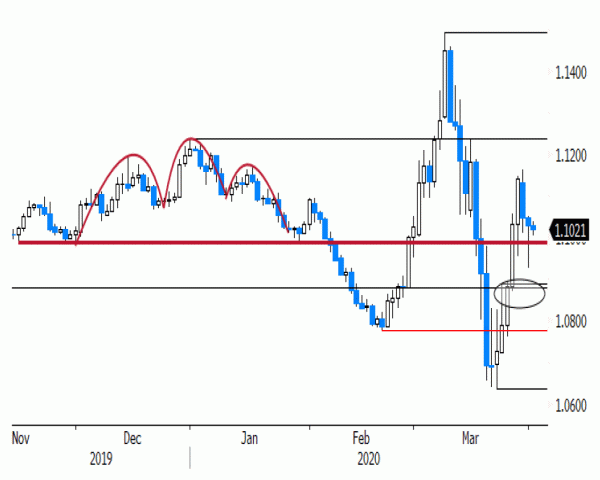- Rates: ADP and manufacturing ISM first important US eco releases
German Bunds traded remarkably stable yesterday with US Treausries slightly outperforming on Fed action and equity weakness. We might have entered some vacuum where monetary/fiscal stimulus currently hangs in the balance with the feared hit on the economy. US ADP employment and manufacturing ISM kick off this week’s key US eco numbers. - Currencies: USD correction to slow after quarter-end USD preference?
Yesterday, the dollar remained in favour for most of the day as investors preferred a cautious positioning at the end of the quarter. However, most USD cross rates (including EUR/USD) didn’t break important technical resistance (support). Will additional Fed measures to provide US liquidity ease the USD bid? USD data are a wildcard
The Sunrise Headlines
- US stocks fell in a choppy trading session and capped Wall Street’s worst quarter since 2008. The DJ underperformed (-1.84%). Asian markets trade mixed under pressure from grim coronavirus figures in the US. Japan underperforms (-4.5%).
- US president Trump warned Americans for “very, very painful two weeks” and extended coronavirus guidelines after the White House estimated the death toll from the coronavirus could reach 240 000, even with mitigation efforts.
- Trump called for a new big and bold $2tn infrastructure bill that would boost jobs as the next move to combat the widespread coronacrisis. Trump reportedly also mulls a 90-day suspension of tariff payments on certain imports.
- China’s Caixin’s manufacturing PMI surged back into expansion territory in March (50.1 from 40.3), echoing yesterday’s official PMI. Japan’s Tankan index for big manufacturers dropped from 0 to -8 in Q1, a level unseen since 2013.
- President Trump is breeding cautious hopes in a possible way out of the damaging stand-off between Russia and Saudi Arabia as he discussed the oil slump with the countries and may join them in talks to resolve their price war.
- The Czech government is chewing over a loan-repayment freeze for 3 to 6 months to soften the blow from the coronacrisis to households and businesses and also considers holding off interest payments except for corporate loans.
- Today’s economic calendar contains US ADP job report and manufacturing ISM which will show the initial impact of the corona pandemic blow. February’s unemployment figures are due in Europe. Germany & Portugal tap the market
Currencies: USD Correction Meets First Support
How important are US eco data for the dollar?
Yesterday, end of month position management was an important driver for trading in global FX. After accumulation USD during the period of global markets stress, economic agents erred to the cautious side on holding this US liquidity. The Fed announcing a new repo facility with other CBs to support USD liquidity outside the US initially had only a modest impact on intraday USD positioning. Still, later the USD rebound eased, even as sentiment was risk-off. The trade-weighted dollar (DXY) even closed marginally lower (99.04) and so did USD/JPY (close 107.54). EUR/USD also reversed an intraday decline to close at 1.1031.
This morning, the China Caixin PMI showed a similar rebound as the official measure yesterday. The BoJ Tankan confidence report showed the expected sharp decline. Whatever the data, risk sentiment remains rather fragile this morning, preventing a further decline of the dollar. The yuan is trading rather stable at 7.0890. USD/JPY is little changed. Idem for EUR/USD (1.1030 area). The Aussie dollar shows tentative signs of its recent rebound running into resistance (AUD/USD 0.9125 area).
Risk sentiment and the preference/availability of USD liquidity remain important drivers for USD trading. We look out whether the prospect of a new Fed window will ease ‘USD stress’ outside the US. Eco data are difficult to interpret these days. Still we keep an eye on the US ISM and the US labour market data (ADP and claims). Will negative US labour market data be a negative for the dollar? On the euro side of the story, markets still look for some kind of coordinated EU ‘fiscal’ initiative.
Of late, we assumed the aggressive run to the USD might slow and that maybe the dollar could enter a cautious sell-on-upticks pattern. The USD was well bid earlier this week, but didn’t regain key technical levels. We keep our cautious sell USD on uptick bias as long as the EUR/USD 1.09 support area holds. EUR/USD 1.1237/50 is a next topside reference.
Yesterday, the sterling outperformance initially continued with EUR/GBP closing below 0.89. Today, the final UK manufacturing PMI probably will only have limited impact on trading. We are a bit puzzled on this week’s outperformance of sterling. The drop below EUR/GBP 0.90 was a euro negative/sterling positive. Still, we remain cautious to join this sterling rebound as the UK is no font-runner in the management of the corona-cycle.
EUR/USD: end-of-quarter preference for USD liquidity to subside. USD didn’t regain important technical resistance.














